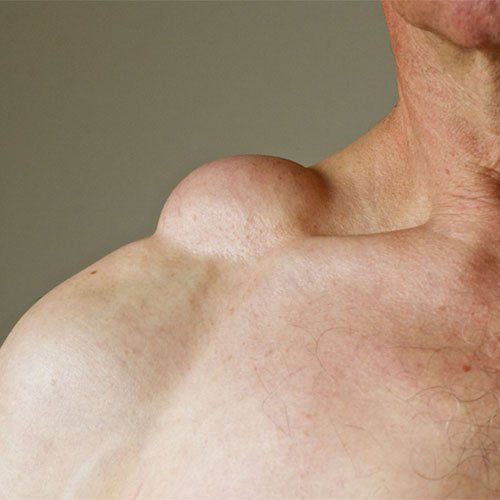
Lipoma
Lipoma
A lipoma is a benign (non-cancerous) tumor made up of fatty tissue. They are the most common type of soft tissue tumor found in adults and can occur anywhere in the body, although they are most often found on the trunk, shoulders, neck, and arms. Lipomas typically feel soft and moveable under the skin. They grow slowly and are generally painless, although they can sometimes press on nerves or surrounding structures, causing discomfort.
Lipomas are generally harmless and do not require treatment unless they cause discomfort or cosmetic concerns. Surgical excision is the most definitive treatment, and patients can expect a good outcome with minimal risk of recurrence. If you suspect you have a lipoma or have concerns about any lumps, it’s advisable to consult a healthcare professional for an accurate diagnosis and appropriate management.

Causes and Risk Factors
The exact cause of lipomas is not well understood, but several factors may contribute to their development:
- Genetics: A family history of lipomas can increase the likelihood of developing them.
- Age: Lipomas are most commonly diagnosed in middle-aged adults (ages 40-60).
- Obesity: While not a direct cause, being overweight may increase the likelihood of developing lipomas.
Symptoms
Most lipomas do not cause symptoms, but they can present as:
- Soft, movable lumps under the skin.
- Growths that vary in size from a few millimeters to several centimeters.
- Rarely, pain or discomfort if they compress nearby structures.
Diagnosis
Diagnosis of a lipoma typically involves:
- Physical Examination: A healthcare provider will examine the lump and assess its characteristics.
- Imaging Studies: In some cases, imaging techniques like ultrasound, MRI, or CT scans may be used to confirm the diagnosis and rule out other conditions.
- Biopsy: Although rare, a small sample of the lipoma may be taken for laboratory analysis if there is uncertainty about its nature.
Treatment Options
Most lipomas do not require treatment unless they cause discomfort, pain, or cosmetic concerns. If treatment is desired, the following options are available:
Surgical Excision: The most common and effective treatment is surgical removal. This is typically done as an outpatient procedure under local anesthesia. The entire lipoma is excised, which minimizes the chance of recurrence.
Liposuction: For smaller lipomas, liposuction may be an option. This involves using a needle and a large syringe to remove the fatty tissue. While this method may leave less scarring, it may not completely remove the lipoma, leading to a chance of recurrence.
Steroid Injections: In some cases, corticosteroid injections can be used to shrink the lipoma. However, this method may not completely eliminate the lipoma, and its effectiveness varies.
Watchful Waiting: If the lipoma is asymptomatic and not bothering the patient, a doctor may recommend monitoring it over time without immediate intervention.
